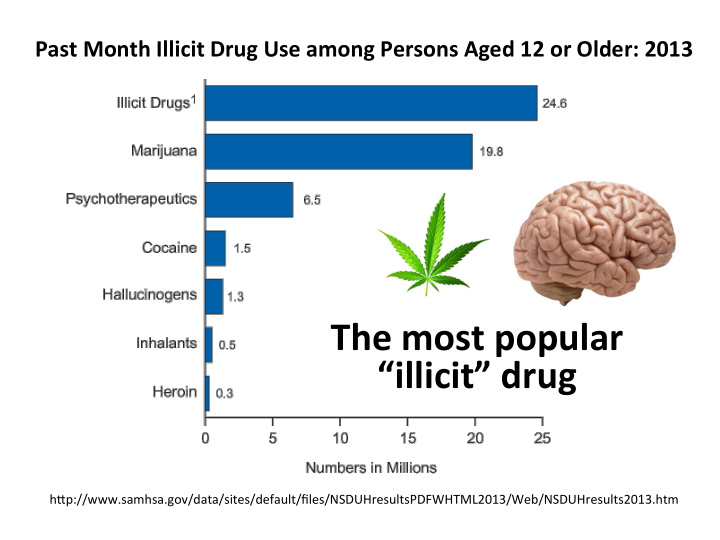



Past Month Illicit Drug Use among Persons Aged 12 or Older: 2013 � The most popular “illicit” drug h#p://www.samhsa.gov/data/sites/default/files/NSDUHresultsPDFWHTML2013/Web/NSDUHresults2013.htm
Marijuana use in the past month among youths aged 12 to 17, by state: percentages, annual averages, 2013-2014; SAMHSA NSDUH
PercepMons of great risk of harm from smoking marijuana once a month among youths aged 12 to 17, by state: percentages, annual averages, 2013-2014; SAMHSA NSDUH
• Harry Anslinger , first Commissioner of NarcoMcs, Bureau of NarcoMcs • “Those who are habitually accustomed to use of the drug are said to develop a delirious rage aQer its administraMon, during which they are temporarily, at least, irresponsible and liable to commit violent crimes …” A history of demonizaMon
Controlled Substances Act (1970) • The drug or other substance… 1. …has a high potenMal for abuse 2. …has no currently accepted medical use • There is a lack of accepted safety for use of the drug…under medical supervision… Marijuana is sMll a Schedule I substance
Cannabis contains cannabinoids Indicas SaMvas • More than 60! • Concentrated in resin • Lots of differences, depending on strain, other factors…
Method of drug administraMon maSers Burning vaporizes cannabinoids, which reach the brain in seconds. Oral administraMon delivers less THC, CBD, CBN, etc. more slowly… Marijuana is smoked…and eaten “I strained to remember where I was or even what I was wearing, touching my green corduroy jeans and staring at the exposed-brick wall. As my paranoia deepened, I became convinced that I had died and no one was telling me…” New York Times, 6/3/13
Cannabinoids act at cannabinoid receptors: CB1 and CB2 CB1 Receptors Abundant! Cerebellum Basal ganglia Hippocampus Brainstem Spinal cord Neocortex ( Herkenham et al. (1991) J. Neurosci. 11: 563 ) CNS expression in areas important for motor coordinaMon, memory, pain, nausea, decision making…
Endogenous cannabinoid neurotransmiSers If we have receptors for cannabinoids like THC, why are they there? What neurotransmi#ers act at these endogenous receptors..? Anandamide Derived from arachidonic acid, 2-AG a fa#y acid found in membranes
Anxiety: GeneMc protecMon? Decreased anxiety in humans and mice with FAAH C385A Anandamide Breakdown by FAAH; several Forms (A, C) A less common; Less effecMve at FAAH geneMc variaMon enhances fronto-amygdala funcMon in mouse breakdown and human, Nature CommunicaMons, Iva Dincheva et al (2015)
Cannabinoids reduce pain A large body of literature indicates that cannabinoids suppress behavioral responses to acute and persistent noxious sMmulaMon… (Walker JM, Hohmann AG, 2005) Co-administraMon of cannabinoids and opiates allows for pain relief with a lower opiate dose! (e.g., Wilson AR, Maher L, Morgan MM, 2008)
More therapeuMc effects • AppeMte sMmulaMon (e.g., FolMn, 1988; Williams, 1988) Why is this therapeuTc? • Nausea relief (e.g., studies referenced by the NaMonal Cancer InsMtute at cancer.gov; though chronic use linked to hyperemesis syndrome; Soriano-Co M, 2010)
Marijuana impairs cogniMon, memory, motor coordinaMon • Deficits in verbal and spaMal memory (e.g., Curran et al, 2002) • With increasing cogniMve demand, there is significantly reduced cogniMve performance… • Cannabis and alcohol both impair skills criMcal for driving (Sewell RA et al, 2009) • DifferenMal effects on socializaMon
Early chronic marijuana exposure linked to persistent cogniMve deficits “…results suggest that adolescents are more vulnerable than adults to neurocogniMve abnormaliMes associated with chronic heavy marijuana use…” Schweinsburg et al (2008) h#p://www.drugabuse.gov/publicaMons/topics-in-brief/marijuana
Risks of chronic adolescent use Volkow et al (2014), NEJM CogniMve impairment : IQ drop • Risk of dependence : 9% of those who experiment; 1 in 6 of those who • start using in adolescence, and 25 – 50% of those who smoke daily… Changes in funcMonal connecMvity • Increased risk of anxiety and depression, and schizophrenia/psychosis in • those with a preexisMng geneMc vulnerability (But from Volkow arMcle: “It is inherently difficult to establish causality in these types of studies because factors other than marijuana use may be directly associated with the risk of mental illness…”) School performance : “Early marijuana use is associated with impaired • school performance…although reports of shared environmental factors… suggest that the relaMonship may be more complex…”
However…we’re sMll learning • Cannabis use is quan2ta2vely associated with nucleus accumbens and amygdala abnormaliMes in young adult recreaMonal users. Nucleus accumbens, amygdala are part of moMvaMonal networks (what you seek, what you avoid…) Gilman JM1, Kuster JK, Lee S, Lee MJ, Kim BW, Makris N, van der Kouwe A, Blood AJ, Breiter HC., J Neurosci. 2014 Apr 16;34(16):5529-38 (2014)
But wait - which is it..? • Daily Marijuana Use Is Not Associated with Brain Morphometric Measures in Adolescents or Adults Barbara J. Weiland, Rachel Thayer, Brendan E. Depue, Amithrupa Sabbineni, Angela Bryan, Kent E. Hutchison, The Journal of Neuroscience, 28 January 2015 Same journal Different research group * Controlled for alcohol exposure…
Past Month Illicit Drug Use Youths Aged 12 to 17: 2002-2013 Substance Abuse and Mental Health Services AdministraMon NaMonal Survey on Drug Use and Health, 2013
Alcohol Use in the Past Month among Youths Aged 12 to 17 , by State; SAMHSA NSDUH Percentages, Annual Averages Based on 2013 and 2014 NSDUHs
Recommend
More recommend